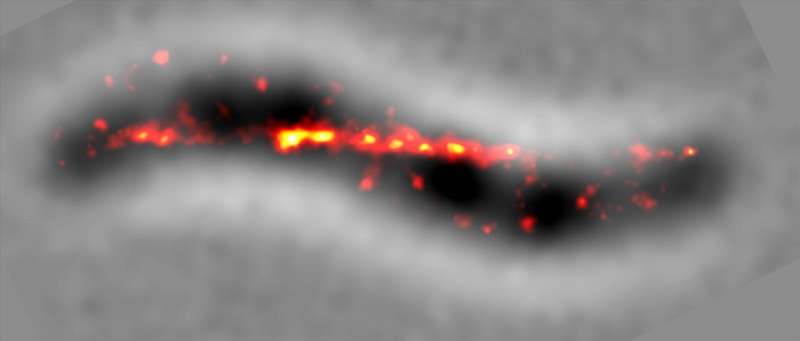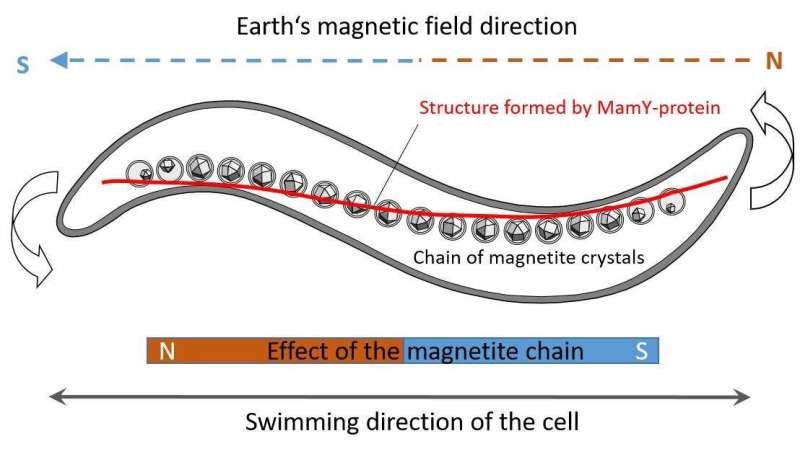Microbiologists solve the mystery of the compass needle in magnetic bacteria

Bacteria of the species Magnetospirillum gryphiswaldense are unicellular organisms that can align their locomotion precisely with the Earth's magnetic field. They owe this ability to tiny magnetite crystals called magnetosomes. In the spiral-shaped bacterial cell, the crystals form a stable, straight chain that acts like a compass needle. Microbiologists at the University of Bayreuth, together with research partners at the Max Planck Institute for Biochemistry in Martinsried and at LMU Munich, have now discovered that the shape and position of the magnetosome chain are largely determined by the protein MamY. In the journal Nature Microbiology they now present their latest findings.
Several animals, such as migratory birds or honey bees, but also certain unicellular organisms, can use the Earth's magnetic field for navigation. While science is still unable to explain this "sixth sense" in animals, it is already partially understood in bacteria. It has long been known that bacteria of the species Magnetospirillum gryphiswaldense are magnetotactic, i.e. they can use the Earth's magnetic field for navigation. Each bacterium forms up to 50 magnetosomes in its cell, which are attached to a thread-like structure. This attachment causes the magnetite crystals not to clump together as a result of their own magnetic pull, but to become lined up, thus assuming the function of a compass needle. This enables the bacteria to follow the orientation of the Earth's magnetic field during their swimming movements and thus reach their preferred habitat, the sediments of water bodies, more quickly.
However, it was a mystery why this flexible chain of magnetosomes took such a stable, linear form—while the bacterial cell assumed a spiral shape. Moreover, short magnetosome chains had been observed in some bacteria, which apparently formed without the already known filamentous structure. The assumption was therefore that there had to be another supporting protein that would help magnetotactic bacteria create their compass needle.

The research team led by Dr. Frank Müller and Prof. Dr. Dirk Schüler at the University of Bayreuth has now discovered this protein. Experiments with highly sensitive instruments and methods, including super-resolution microscopy and cryo-electron tomography, have shown: The structural protein MamY not only causes the straight-line arrangement of the magnetosome chain, but also places this chain in the bacterial cell in a position optimized for the alignment of the swimming movements with the Earth's magnetic field, i.e. exactly parallel to the longitudinal axis of the cell. In bacteria that do not contain MamY, the magnetite crystals form a chain, but not in a linear form. The compass needle is bent, so to speak, which causes the cells to wobble as they swim. And in bacteria without the known filamentous structure, no chains can be detected at all because the magnetosomes simply clump together.
"All these observations confirm the conclusion: MamY is the key protein that arranges the magnetosome chain in the cell in such a way that the function of a compass needle is perfectly fulfilled. The protein enables the bacteria to navigate optimally," explains Dr. Frank Müller, lead author of the study and scientist at the Department of Microbiology at the University of Bayreuth.
In their publication, the researchers also show how the structural protein MamY succeeds in placing the rod-shaped compass needle in the spiral-shaped bacterial cell. It recognizes the areas where the curvilinear cell surface has the strongest curvature. In doing so, it marks the shortest connection between the two ends of the cell, the so-called "geodetic axis." The magnetosome chain is then anchored here. This enables the bacterium to move along the Earth's magnetic field with high precision.
More information: Mauricio Toro-Nahuelpan et al. MamY is a membrane-bound protein that aligns magnetosomes and the motility axis of helical magnetotactic bacteria, Nature Microbiology (2019). DOI: 10.1038/s41564-019-0512-8
Journal information: Nature Microbiology
Provided by University of Bayreuth




















